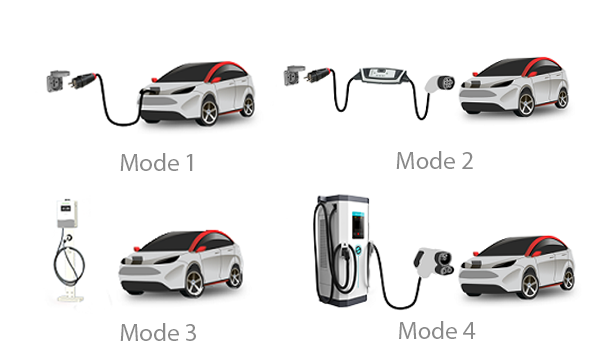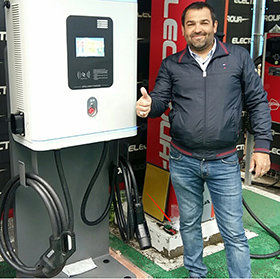One of the most realistic new EV users have to face is how to charge their EVs. Today we will share some basics about EV charging modes, see them in detail.

Mode 1 charging technology refers to home charging from a standard power outlet with a simple extension cord. It consists of the direct connection of the electric vehicle to the normal current sockets without special safety systems. This method of charging does not provide users with shock protection against DC currents.
This charging mode has been prohibited in many areas. In most cases, mode 1 is used for charging electric bikes and scooters.
Mode 1 provides 2.3kW AC power, and the rated values for current and voltage shall not exceed 16 A and 250 V in single-phase while 16 A and 480 V in three-phase.
With an average consumption of 17 kWh per 100 km, you need about 8 hours to recharge for a distance of 100 km at a charging capacity of 2.3 kW.
In Mode 2 charging, the charging system is placed on the charging cable and is called the Control box. Typically installed on portable chargers for electric vehicles.
Mode 2 charging cables have built-in protection in the cables which protects against electric shock. Currently, it's the most common mode of charging EVs.
Mode 2 provides 2.3kW AC power, and the rated values for current and voltage shall not exceed 32 A and 250 V in single-phase while 32 A and 480 V in three-phase.
Mode 3 requires that the vehicle is charged through a power supply system permanently connected to the electrical network. The AC EV charging pile at office or a home-mounted wall box both belong to this mode. Mode 3 charging provides shock protection against AC or DC currents. Mode 3 charging is currently the preferred means of EV charging.
Mode 3 provides 3.7kW to 22kW AC power, and the rated values for current and voltage shall not exceed 32 A and 250 V in single-phase while 32 A and 480 V in three-phase.
| Charger | Phases | Consumption | Distance | Time |
| 3,7 kW | Mono | 17 kWh | 100 Km | ~ 4,6 h |
| 7 kW | Mono | 17 kWh | 100 Km | ~ 2,4 h |
| 11 KW | Tri | 17 kWh | 100 Km | ~ 1,5 h |
| 22 kW | Tri | 17 kWh | 100 Km | ~ 0,8 h |
Mode 4 is often referred to as DC fast charger or level 3 charger. Usually, the rapid charging station has a much larger size than an AC charger. This is due to the presence of the converter that transforms the current from AC into DC before passing through the charging cable toward the electric car.
For this mode, there are two standards, Japanese CHAdeMO and European CCS Combo.
For now, the output power of the mode 4 DC charger varies from 22kW to 350kW, and soon 400kW supercharger standards will be rolled out soon.
With an average consumption of 17 kWh per 100 km, you need about half an hour to recharge for a distance of 100 km at a fast charger with a charging capacity of 60 kWh.

-- Marcus Groll,A Charging Station Owner in UKRAINE
Start your EV charging station businesses with Grasen. For a no-obligation quote, hit the button below, fill in your details, and we’ll get back to you.
